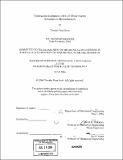| dc.contributor.advisor | Gareth H. McKinley. | en_US |
| dc.contributor.author | Scott, Timothy Peter, 1980- | en_US |
| dc.contributor.other | Massachusetts Institute of Technology. Dept. of Mechanical Engineering. | en_US |
| dc.date.accessioned | 2005-06-02T19:17:58Z | |
| dc.date.available | 2005-06-02T19:17:58Z | |
| dc.date.copyright | 2004 | en_US |
| dc.date.issued | 2004 | en_US |
| dc.identifier.uri | http://hdl.handle.net/1721.1/17948 | |
| dc.description | Thesis (S.M.)--Massachusetts Institute of Technology, Dept. of Mechanical Engineering, 2004. | en_US |
| dc.description | Includes bibliographical references (p. 145-154). | en_US |
| dc.description.abstract | An experimental study is conducted on the nature of extensional flows of mobile dilute polymer solutions in microchannel. By observing such fluids on the microscale it is possible to generate large strain rates ([approximately] 50,000 s⁻¹) that are greater than values which have been observed in macroscale contraction flows. Subsequently, large Deborah numbers (equivalent to those observed on the macro scale in high viscosity solutions) are generated for low viscosity solutions without the interplay of significant inertial effects. High quality microfluidic channels are fabricated using soft lithography techniques. Rheological behavior in these channels is dominated by an abrupt planar contraction, which generates extensional flow in the working fluids. Dilute viscoelastic aqueous solutions of polyethylene oxide are passed through 16:1 planar micro-contractions. Fluids exhibit substantial elastic behavior marked by elastic instabilities followed by subsequent lip vortices and eventually stable vortex growth. The onset of flow instabilities (De =50) and the nature of vortex growth are similar for PEO solutions at various concentrations. Differential pressure measurements indicate that substantial extensional thickening occurs at the onset of flow instabilities and indicate that planar extensional viscosities grow rapidly with increasing strain rates. Also apparent Trouton ratios are calculated indicating that extensional viscosities are two orders of magnitude larger than shear viscosities at high Deborah numbers. | en_US |
| dc.description.statementofresponsibility | by Timothy Peter Scott. | en_US |
| dc.format.extent | 154 p. | en_US |
| dc.format.extent | 10069547 bytes | |
| dc.format.extent | 10069352 bytes | |
| dc.format.mimetype | application/pdf | |
| dc.format.mimetype | application/pdf | |
| dc.language.iso | eng | en_US |
| dc.publisher | Massachusetts Institute of Technology | en_US |
| dc.rights | M.I.T. theses are protected by copyright. They may be viewed from this source for any purpose, but reproduction or distribution in any format is prohibited without written permission. See provided URL for inquiries about permission. | en_US |
| dc.rights.uri | http://dspace.mit.edu/handle/1721.1/7582 | |
| dc.subject | Mechanical Engineering. | en_US |
| dc.title | Contraction/expansion flow of dilute elastic solutions in microchannels | en_US |
| dc.type | Thesis | en_US |
| dc.description.degree | S.M. | en_US |
| dc.contributor.department | Massachusetts Institute of Technology. Department of Mechanical Engineering | |
| dc.identifier.oclc | 56842292 | en_US |
